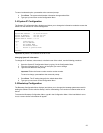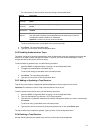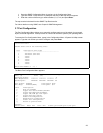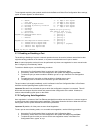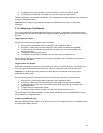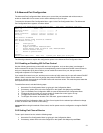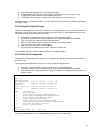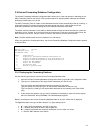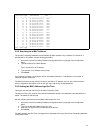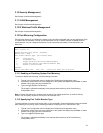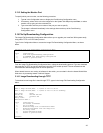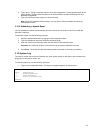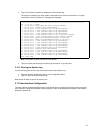
33
3.9 Unicast Forwarding Database Configuration
The Unicast Forwarding Database Configuration Menu allows you to view and search for addresses in the
MAC Forwarding Table on the switch. It also provides options for displaying MAC addresses and IP/MAC
binding by individual port or by VLAN.
The MAC Forwarding Table is a table of node addresses that the switch automatically builds by “learning.” It
performs this task by monitoring the packets that pass through the switch, checking the source and
destination addresses, and then recording the source address information in the table.
The switch uses the information in this table to decide whether a frame should be forwarded to a particular
destination port or “flooded” to all ports other than the received port. Each entry consists of three parts: the
MAC address of the device, the port number on which it was received, and the VLAN number.
Note: The MAC address table can hold a maximum of 8,192 entries.
When you type
d
in the Configuration Menu, the Unicast Forwarding Database Configuration Menu appears,
as shown below.
IntraCore 3524 Unicast Forwarding Database Configuration Menu
Age-out Time: 300 sec.
MAC Address Count: 13
IP Address Count: 10
<Cmd> <Description>
a Display All Forwarding Database With/Without IP
p Display Forwarding Database By Port With/Without IP
v Display Forwarding Database By VLAN With/Without IP
m Search for MAC Address
i Search for IP Address
t Set Age-Out Time
q Return to previous menu
Command>
3.9.1 Displaying the Forwarding Database
Use the following procedure to view the Unicast Forwarding Database table.
1. Open the Unicast Forwarding Database Configuration Menu by typing
d
in the Configuration Menu.
2. Type
a
,
p
or
v
, depending on the range of MAC addresses you want to view.
Type a to display the MAC addresses learned on all ports on the switch.
Type p to specify a unit and port (you will see the MAC addresses for that port only).
Type
v
to specify a VLAN (you will see the MAC addresses for the member ports of that VLAN
only).
3. At the prompt that appears, type y to see IP addresses in the display or type n to see the display
without IP addresses, then press Enter. The selected display appears.
Below is an example of the Unicast Forwarding Database table for all ports, without the IP displayed.
The
Type
field refers to the type of MAC address. The Type setting may be:
• S — static (set by management, and will not age out)
• D
— dynamic (learned by the switch; will be aged out)
• M
— multiple (associated with multiple IP addresses, as in the case of a router)
• I — Self (the MAC address of the switch)



